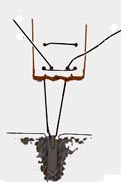- Discussion:
- rotator cuff repair (menu)
- mobilization of rotator cuff
- convergence repair
- restoration of footprint
- knot tying techniques
- Considerations for Arthroscopic Repair:
- required steps: there are several steps for arthroscopic cuff repair and each step needs to be optimally performed w/o interfering w/ other steps;
- passage of sutures for optimal tendon grasp
- bone anchor insertion
- tensioning of sutures (rather than using knots)
- locking of sutures to anchor (rather than locking of the sutures against bone)
- Suture Bone Tunnel Repair: (Open Repair)
- Bone Anchor Technique:
- modified convergence technique:
- bone anchors are inserted at anterior aspect of supraspinatus foot print;
- direction of insertion:
- insertion of anchors at a 45 deg angle to the bone surface is recommended;
- references:
- Early pullout of lateral row knotless anchor in rotator cuff repair
- Proper insertion angle is essential to prevent intra-articular protrusion of a knotless suture anchor in shoulder rotator cuff repair
- Tendon Suture Passage Considerations:
- core sutures for hand flexor tendon lacerations
- Charlotte Shoulder System
- Rip Stop Repair Techniques:
- A load-sharing rip-stop fixation construct for arthroscopic rotator cuff repair.
- Bone Anchor Options:
- suture knots need to be kept lateral to the greater tuberosity so as to avoid impingement under the acromion;
- SpeedScrew (lateral row)
- JuggerKnot (medial row)
- Mitek Healix Anchor
- HEALIX TM BR Anchor with ORTHOCORD Suture Anchor In-Vitro Performance
- HEALIX TM BR & HEALIXTM PEEK Anchor with ORTHOCORD Suture Abrasion White Paper
- References
A biomechanical evaluation of suture anchors in repair of the rotator cuff.
The strength of surgical repairs of the rotator cuff. A biomechanical study on cadavers.
The mechanical effects of suture anchor insertion angle for rotator cuff repair.
Rotator Cuff Repair. A Biomechanical Comparison of Three Techniques.
Primary fixation strength of rotator cuff repair techniques: a comparative study.
Full-thickness rotator cuff tears. A biomechanical comparison of suture versus bone anchor techniques.
Cyclic loading of anchor-based rotator cuff repairs: confirmation of the tension overload phenomenon and comparison of suture anchor fixation with transosseous fixation.
Biomechanical Evaluation of Arthroscopic Rotator Cuff Repairs: Double-Row Compared with Single-Row Fixation.
Arthroscopic Double-Row and “Transosseous-Equivalent” Rotator Cuff Repair
Humeral Insertion of the Supraspinatus and Infraspinatus. New Anatomical Findings Regarding the Footprint of the Rotator Cuff
Vascularity of the supraspinatus tendon three months after repair: Characterization using contrast-enhanced ultrasound.
Tendon-Bone Interface Motion in Transosseous Suture and Suture Anchor Rotator Cuff Repair Techniques
Original Text by Clifford R. Wheeless, III, MD.
Last updated by Clifford R. Wheeless, III, MD on Thursday, April 9, 2015 6:52 am






